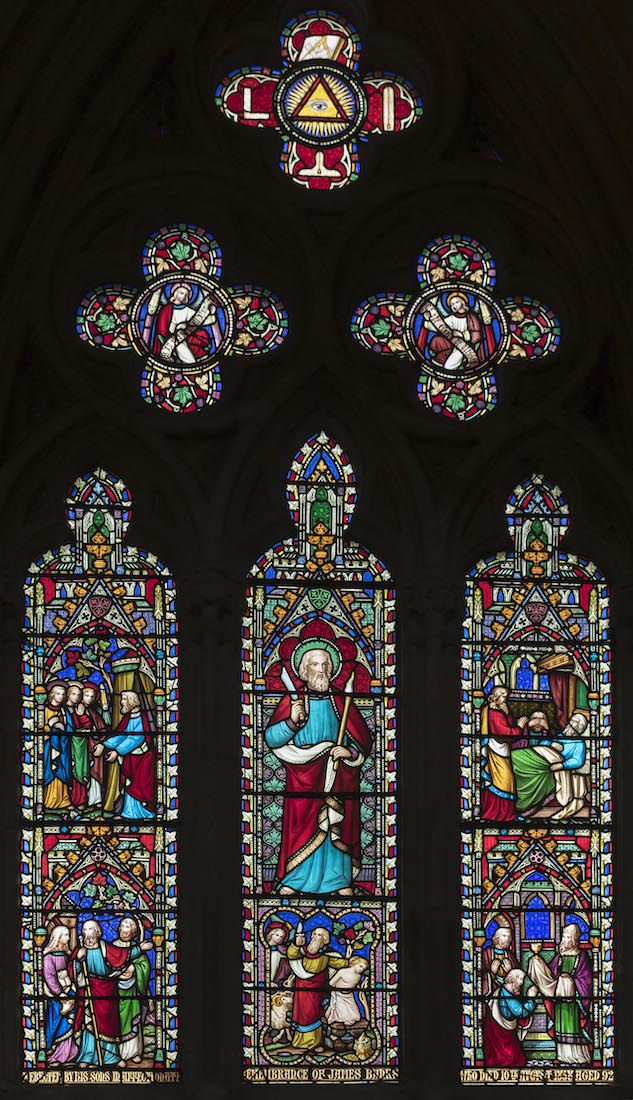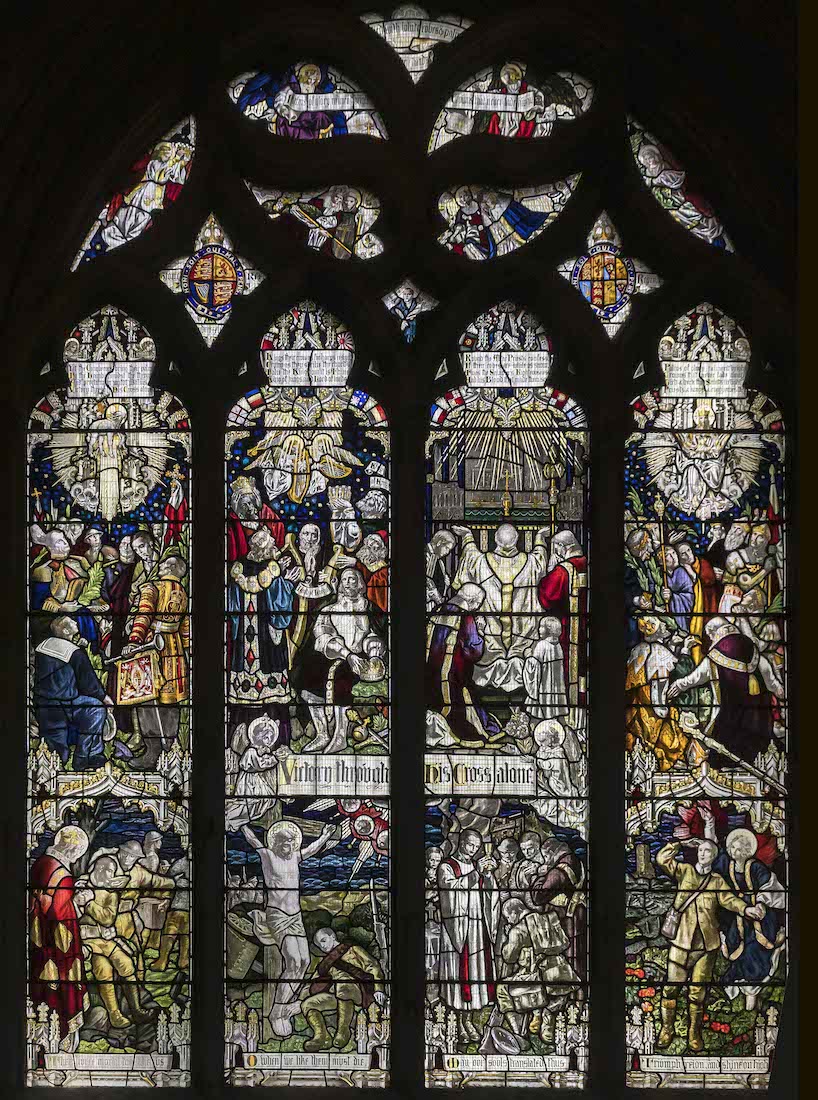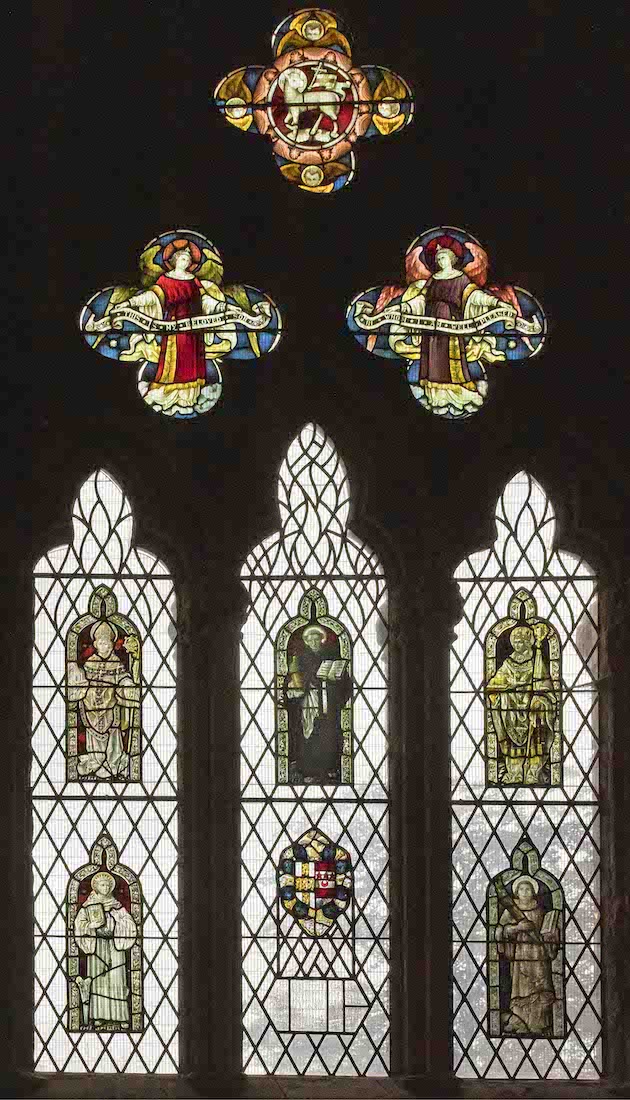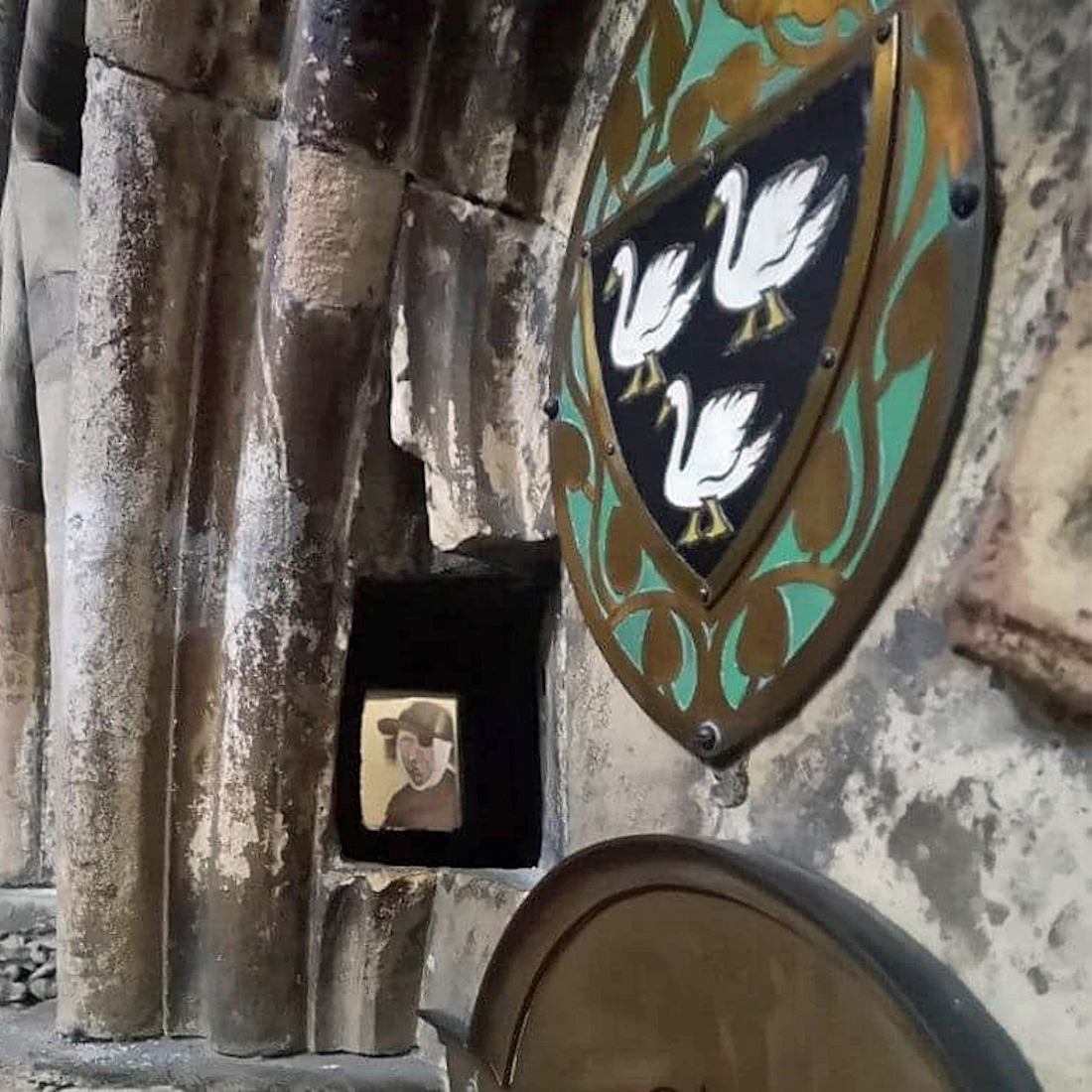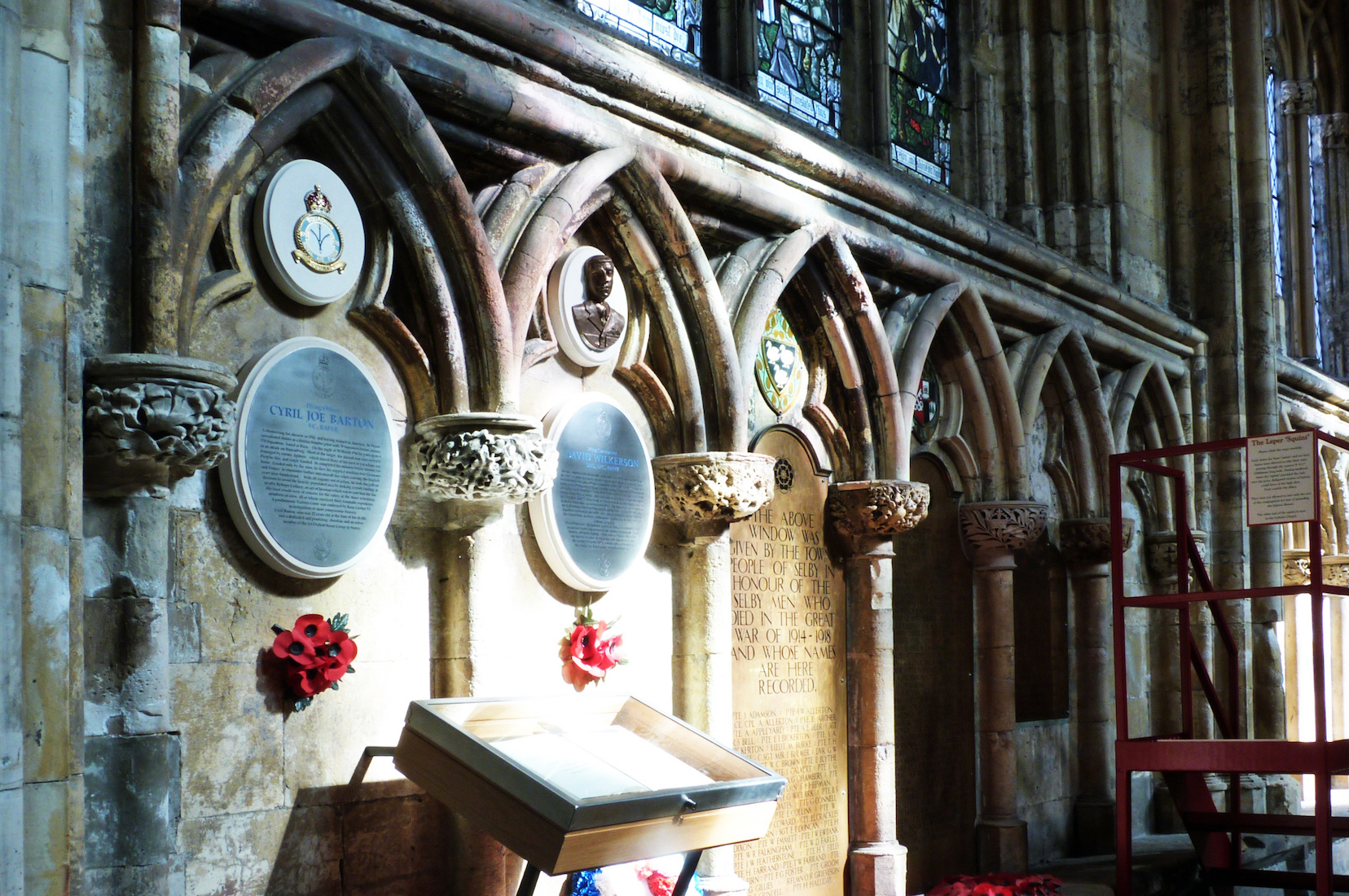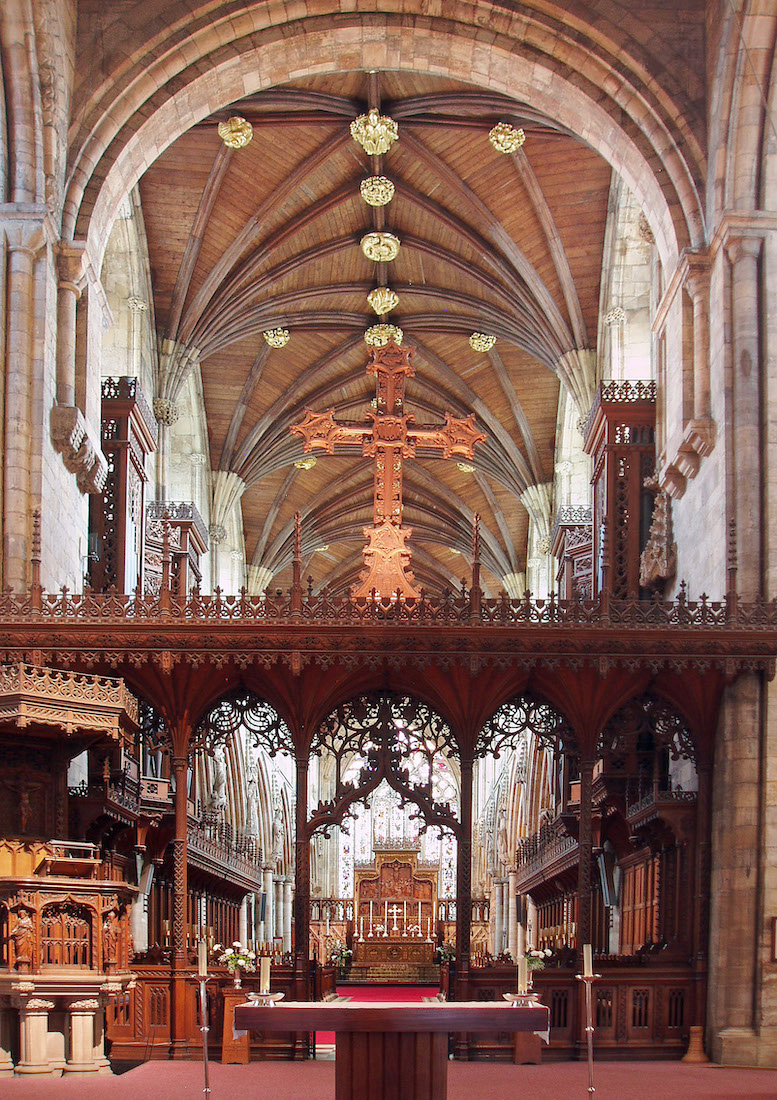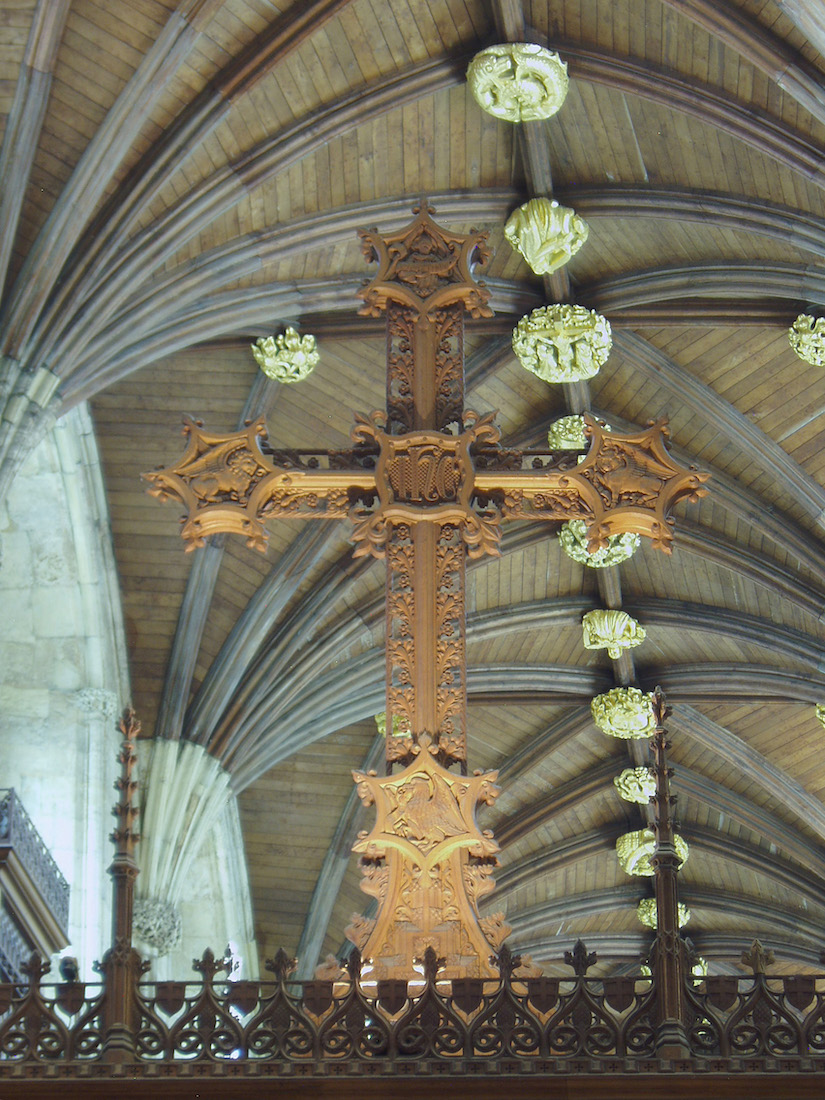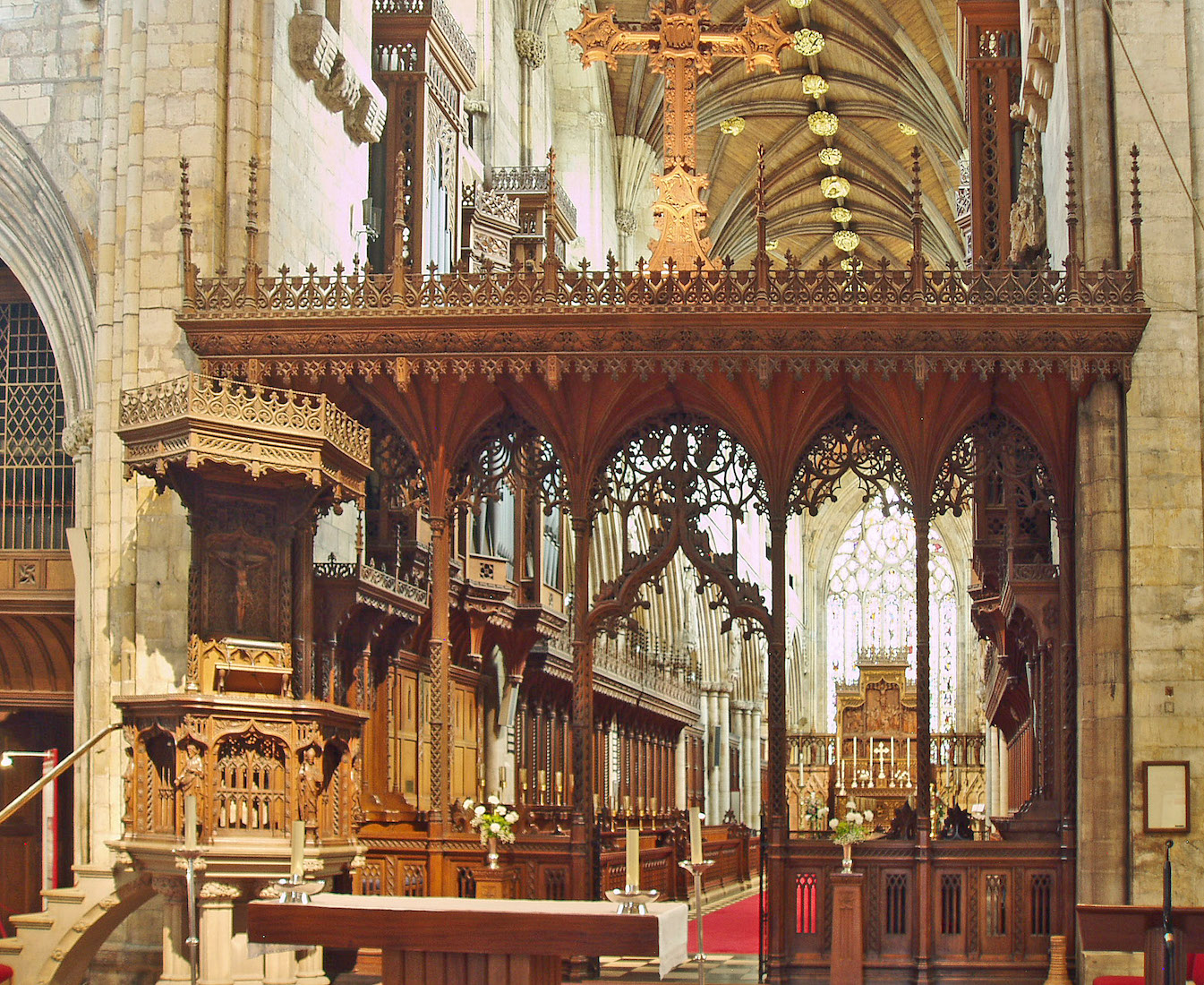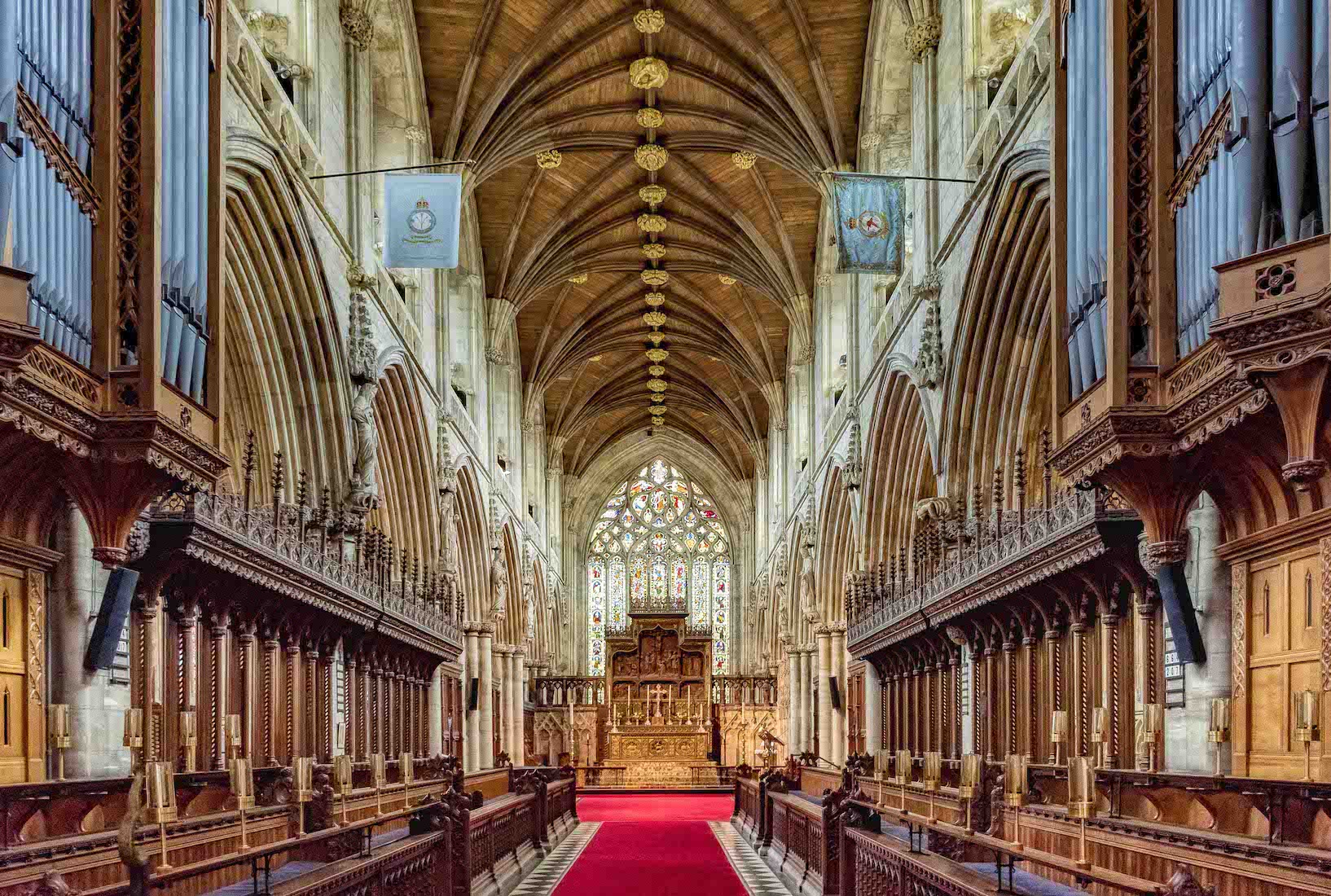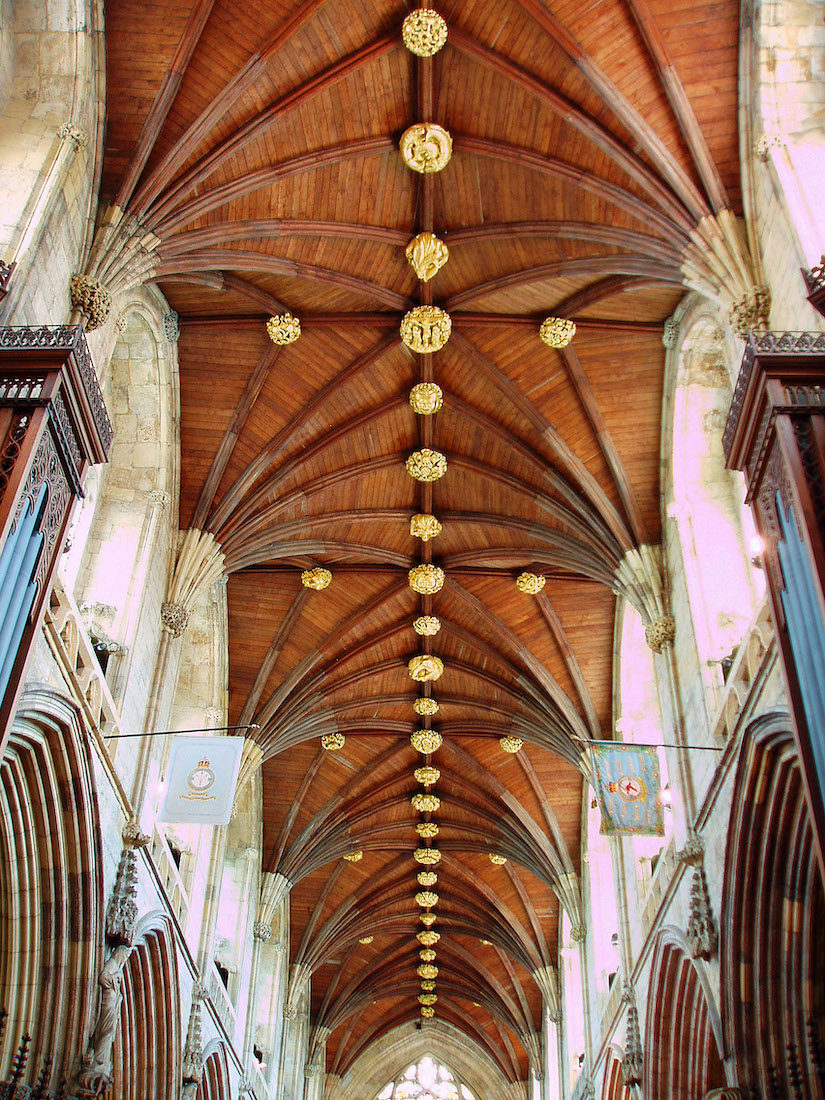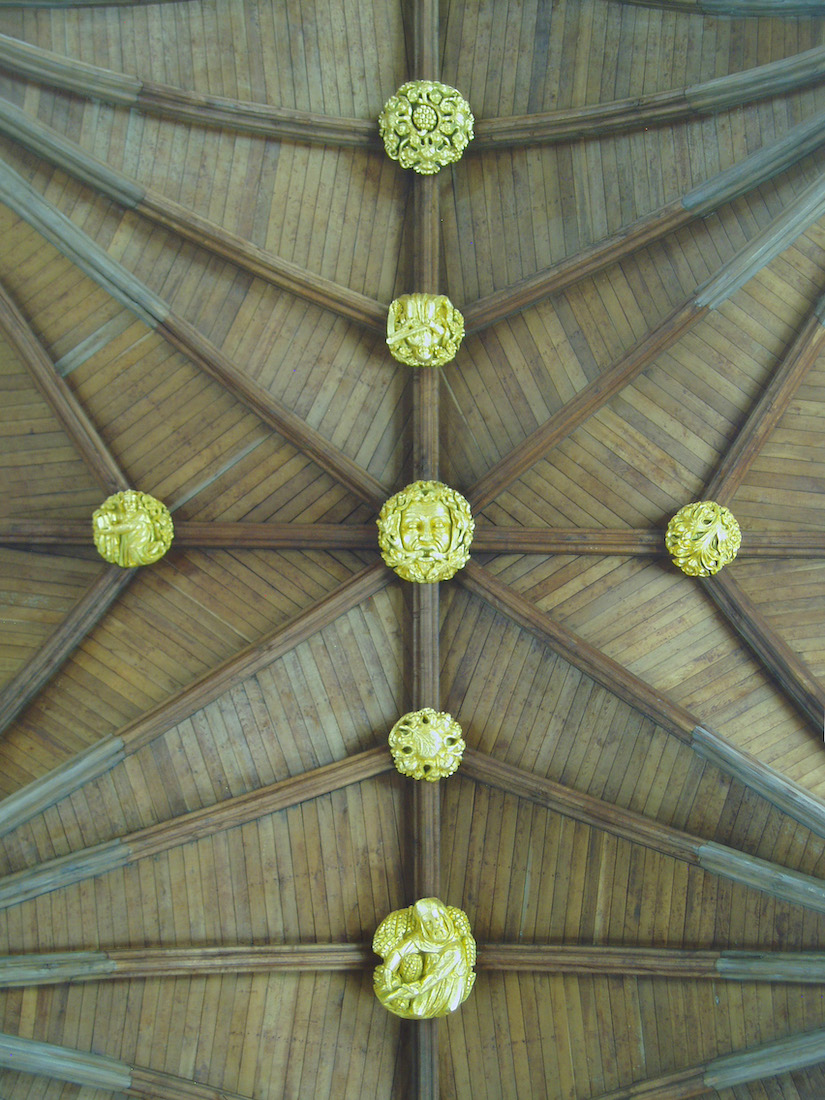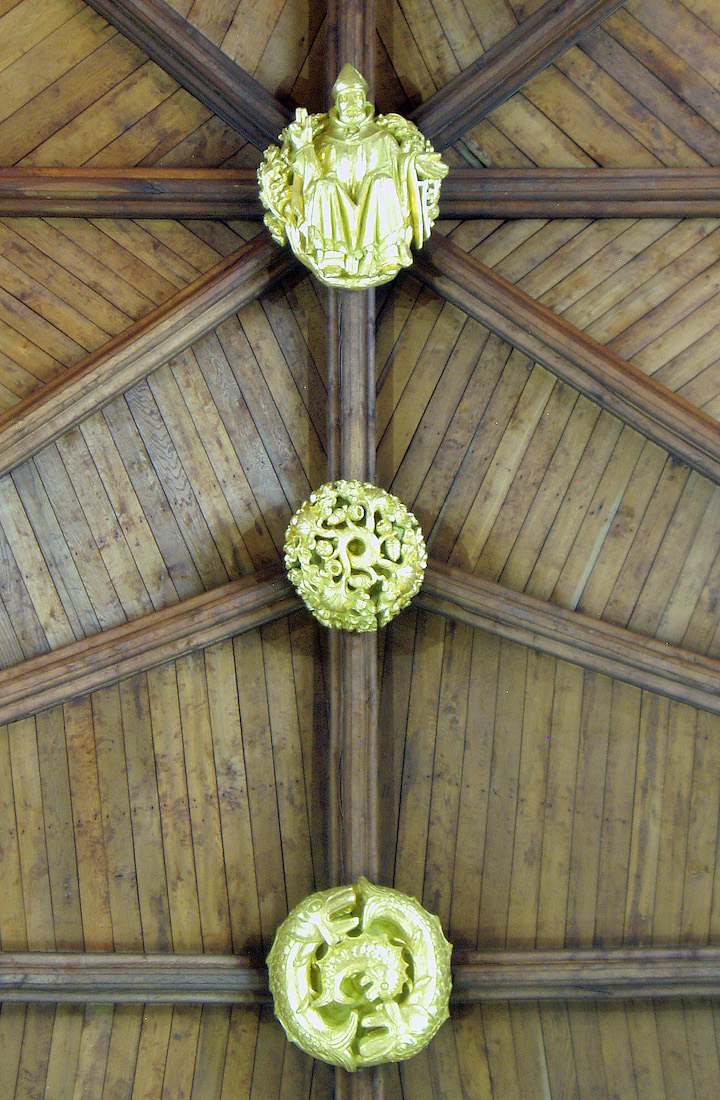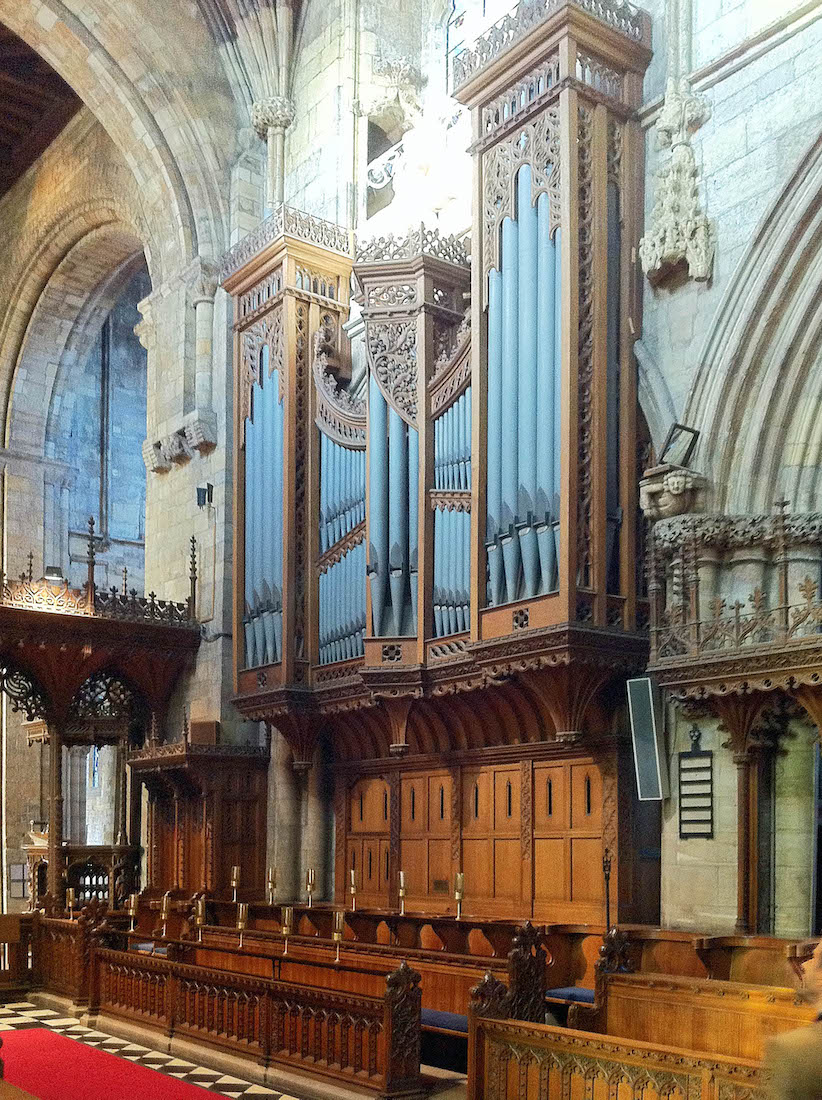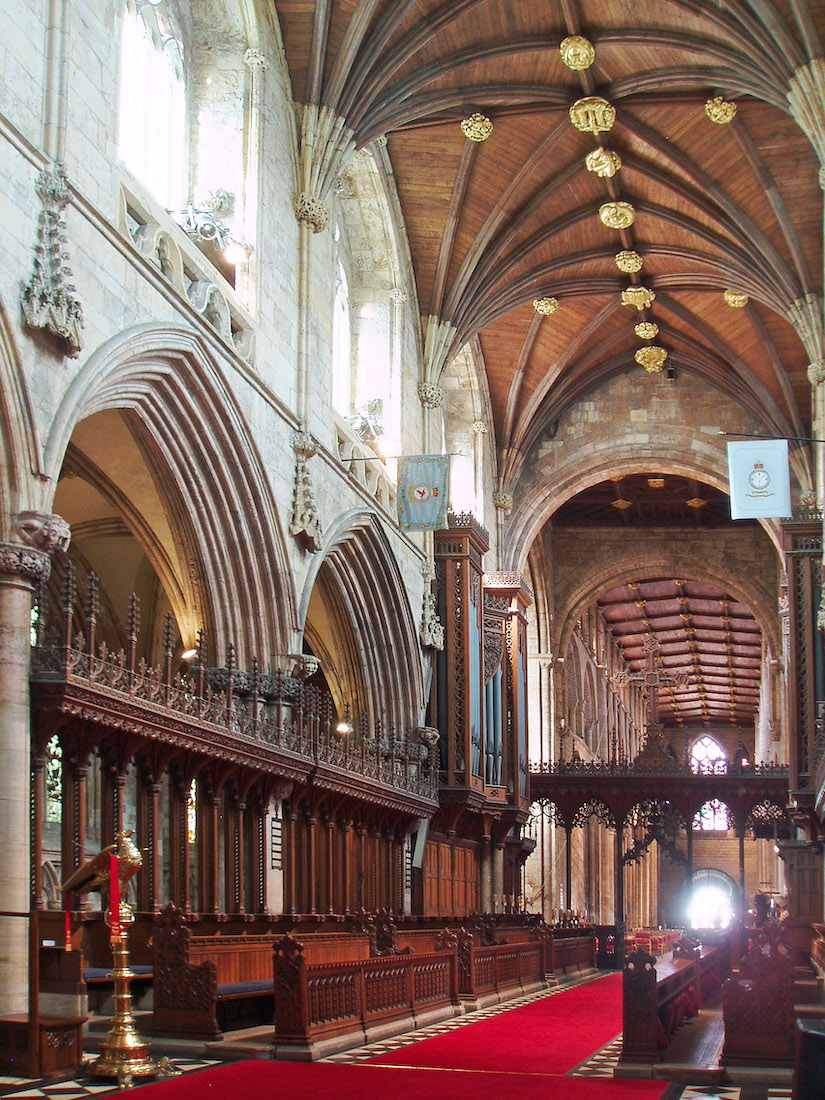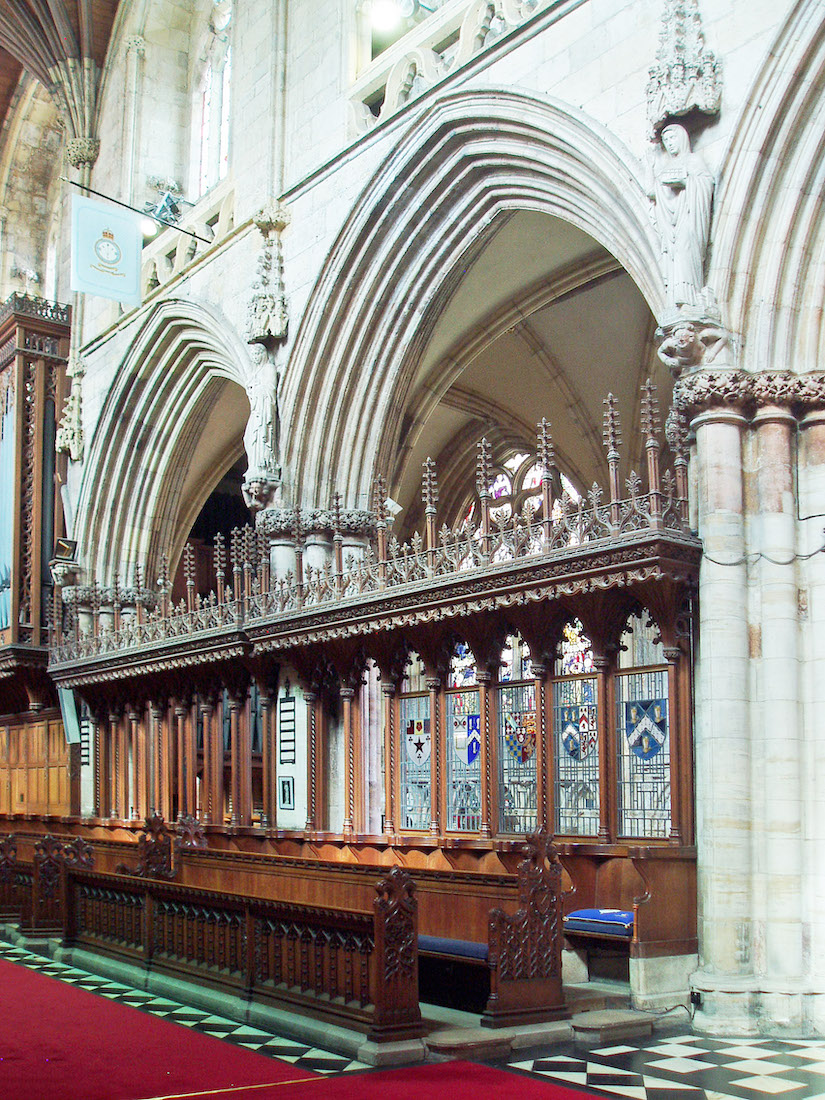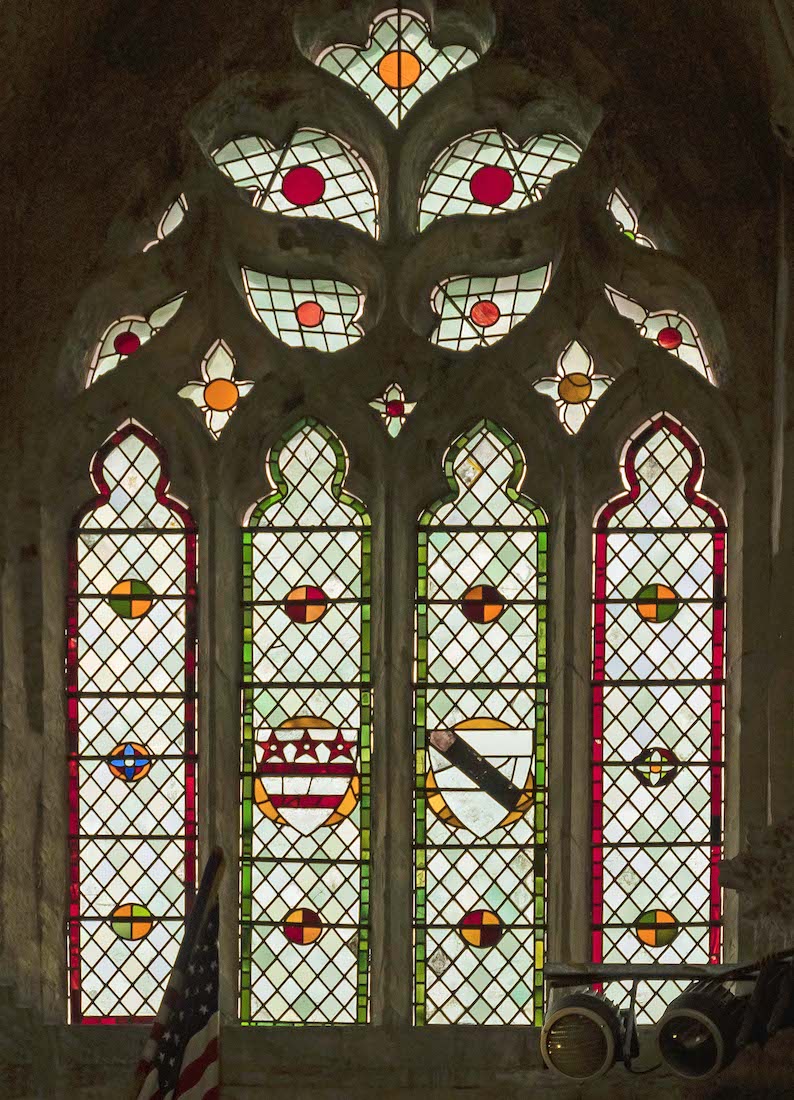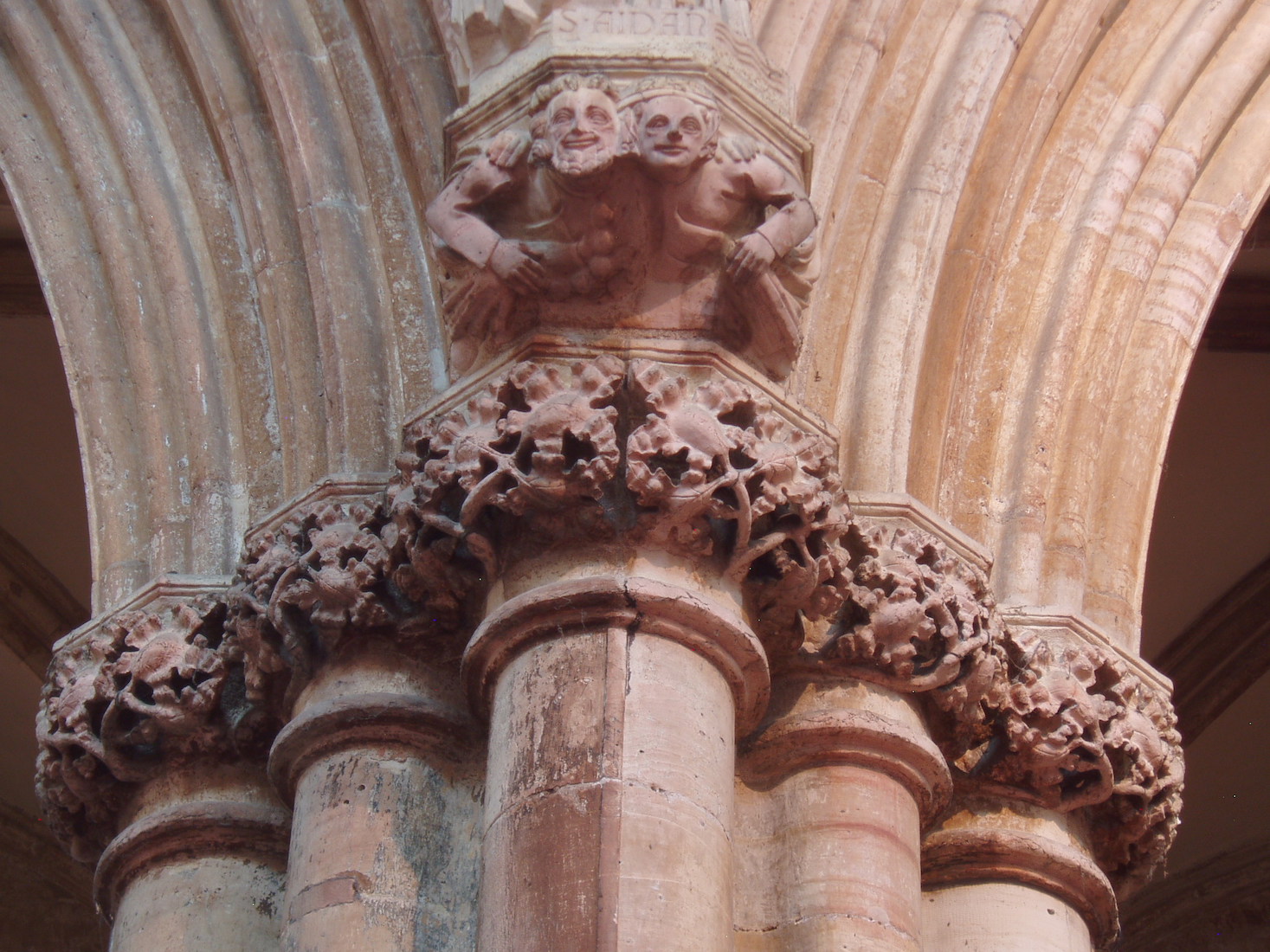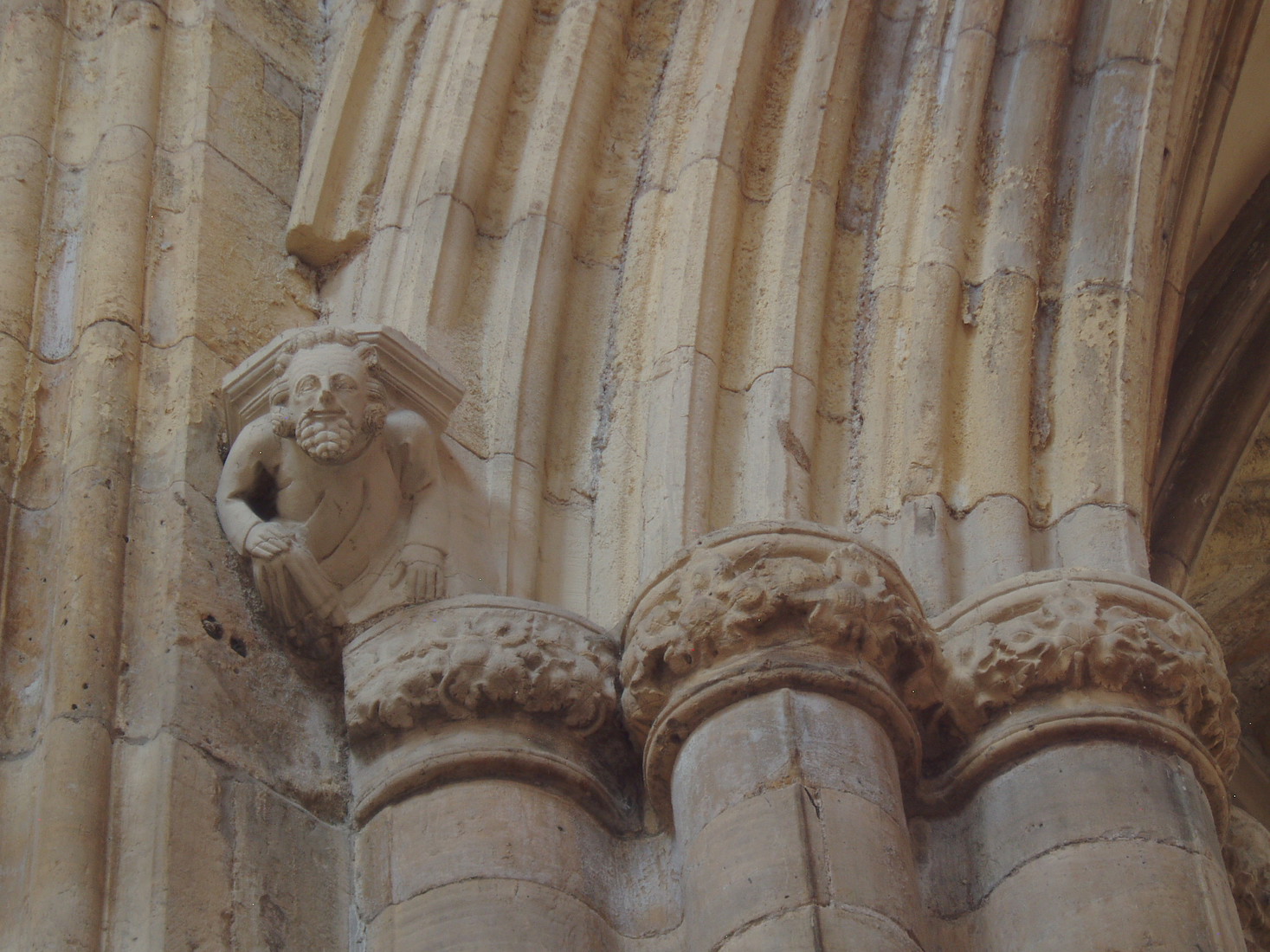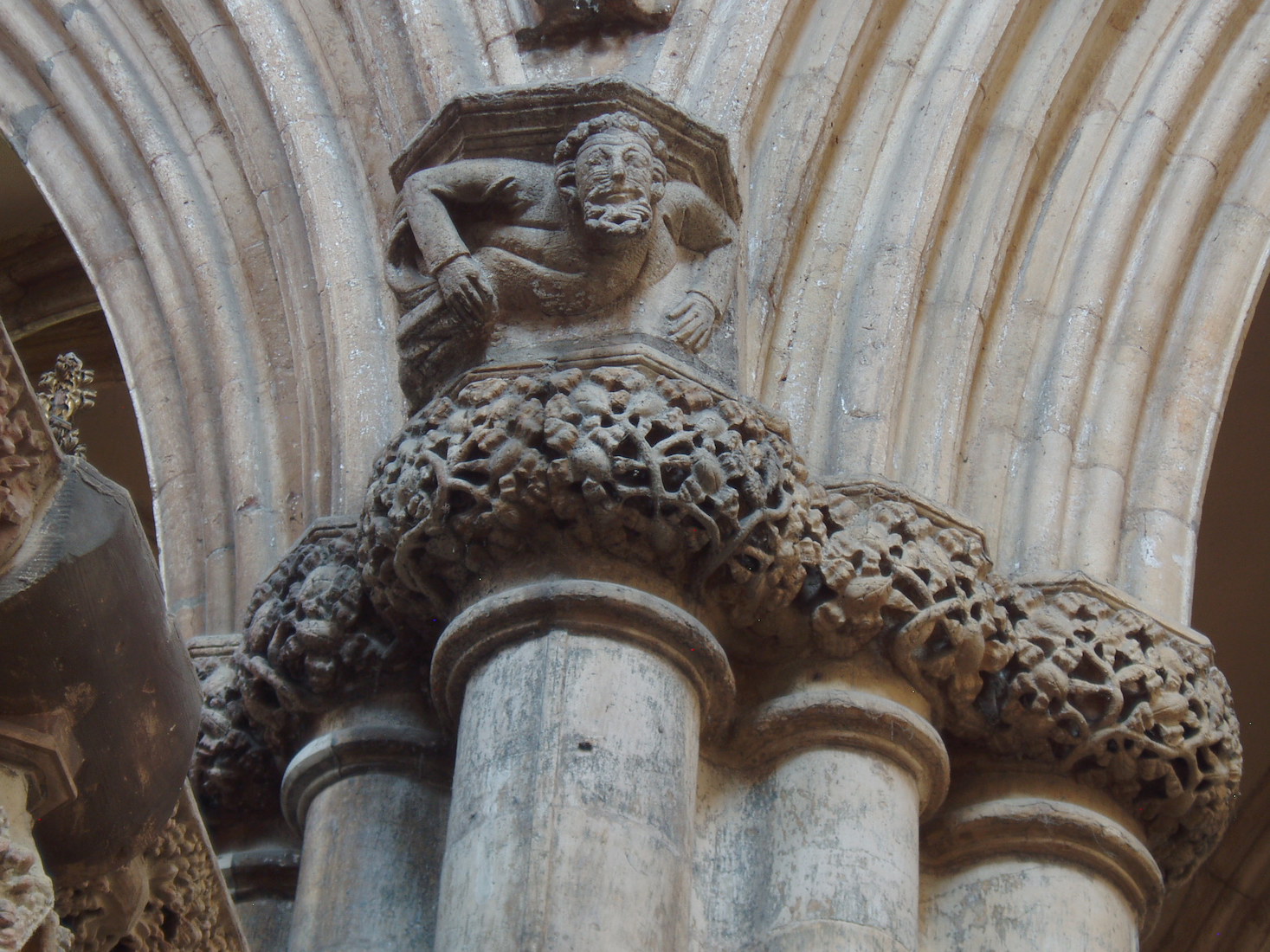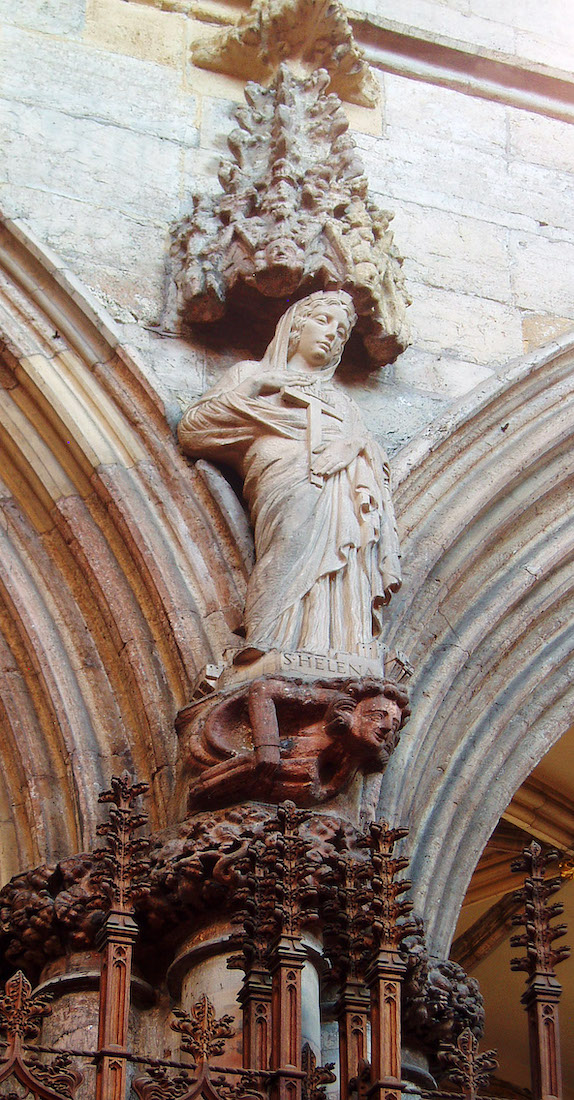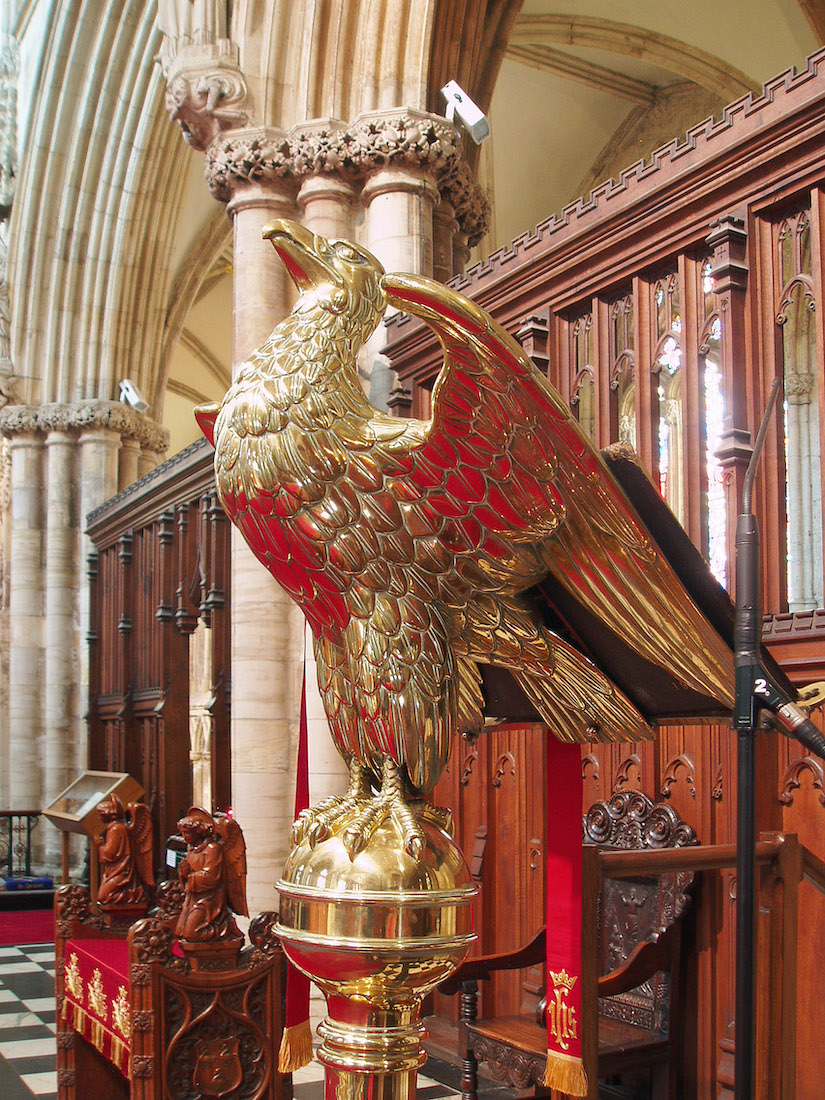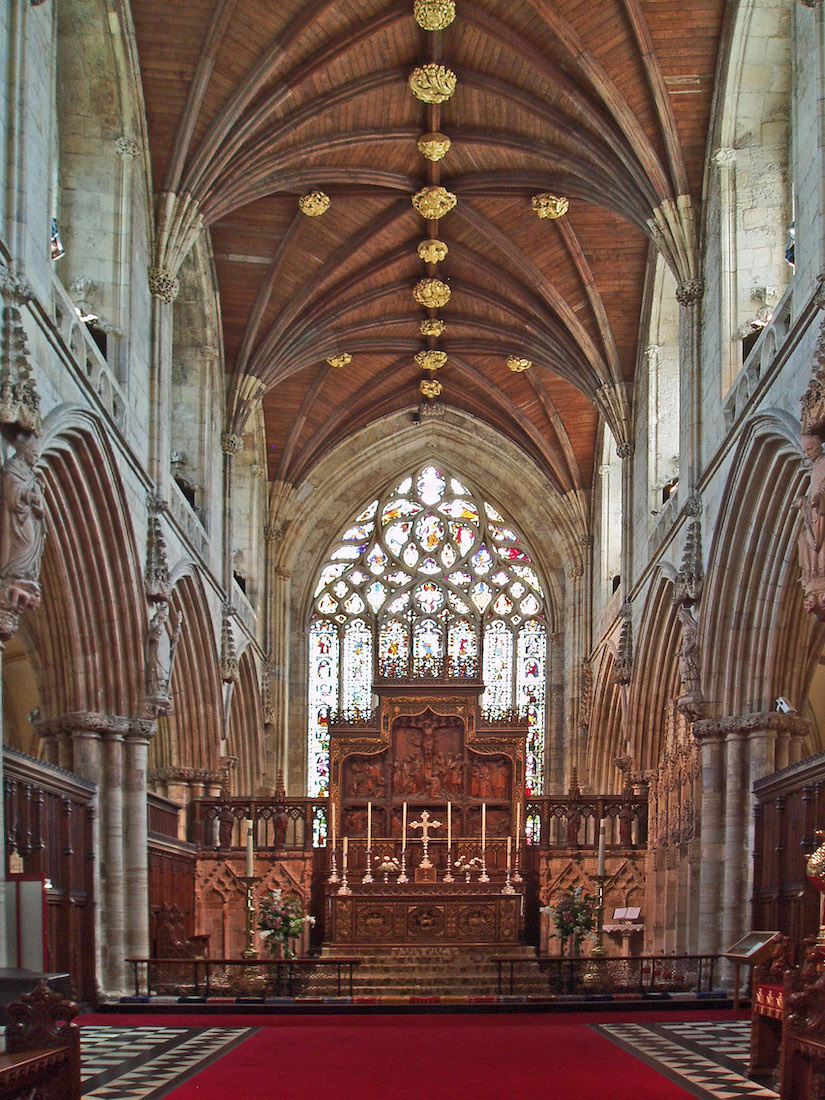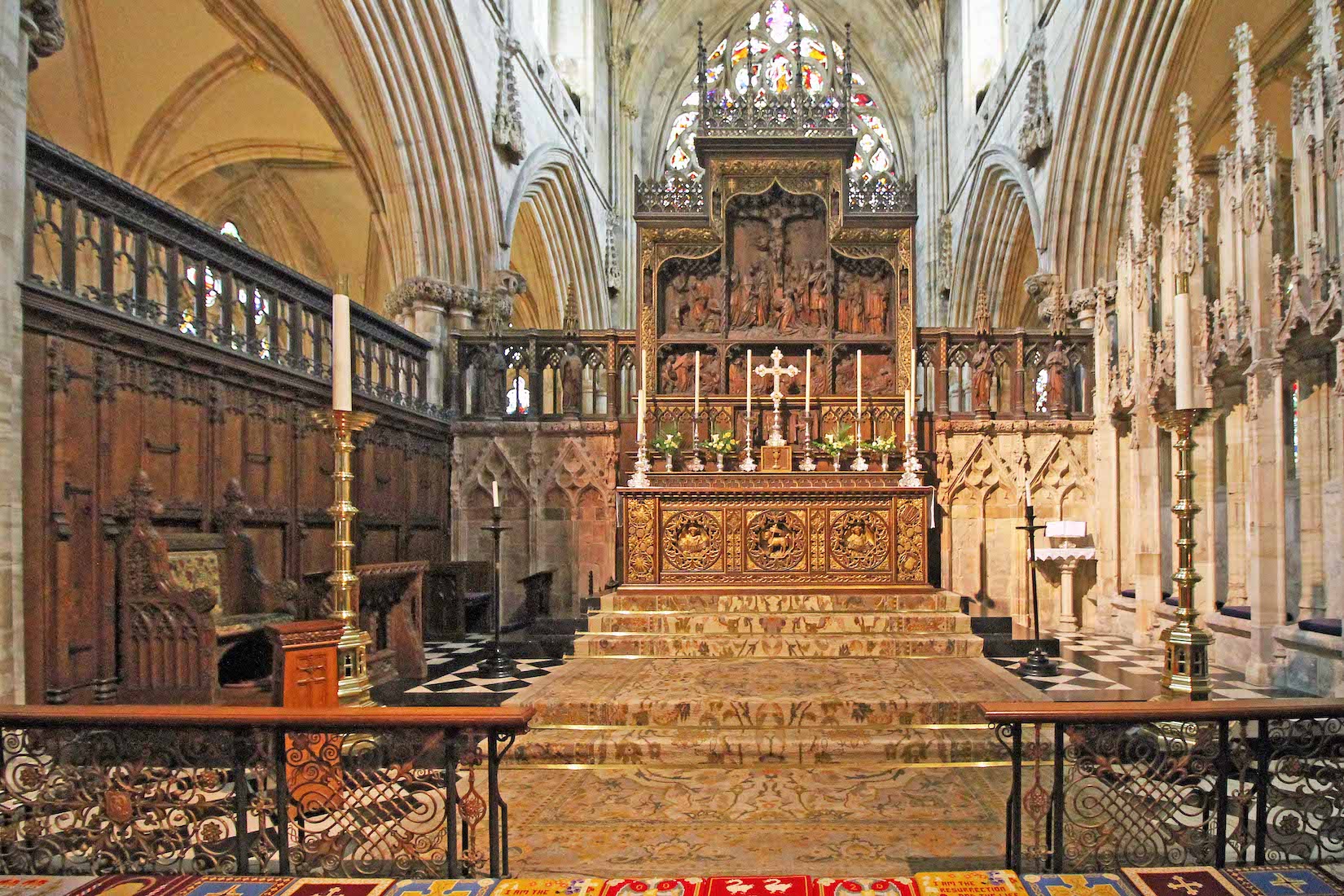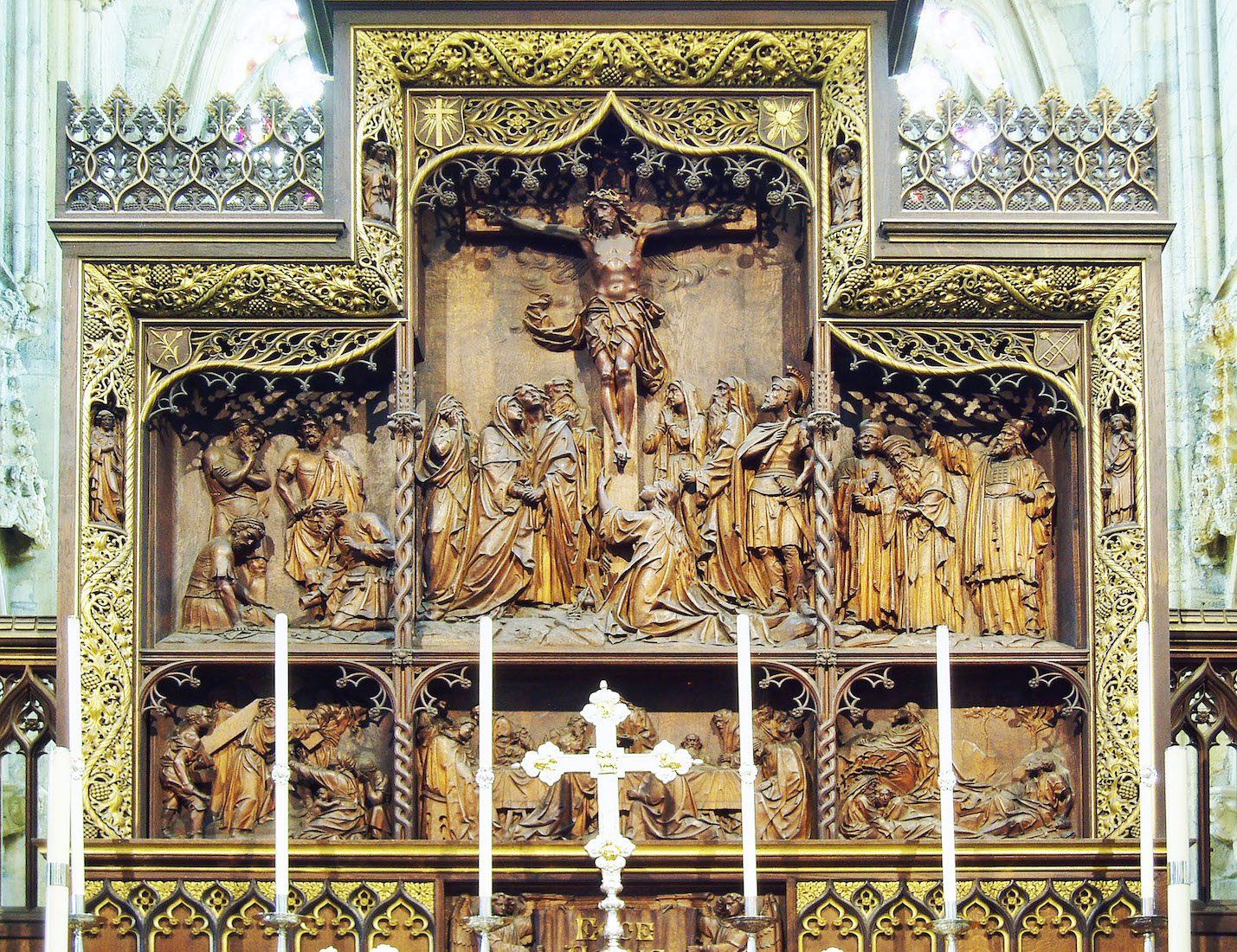D16. NORTH CHOIR AISLE ARCADE JAC
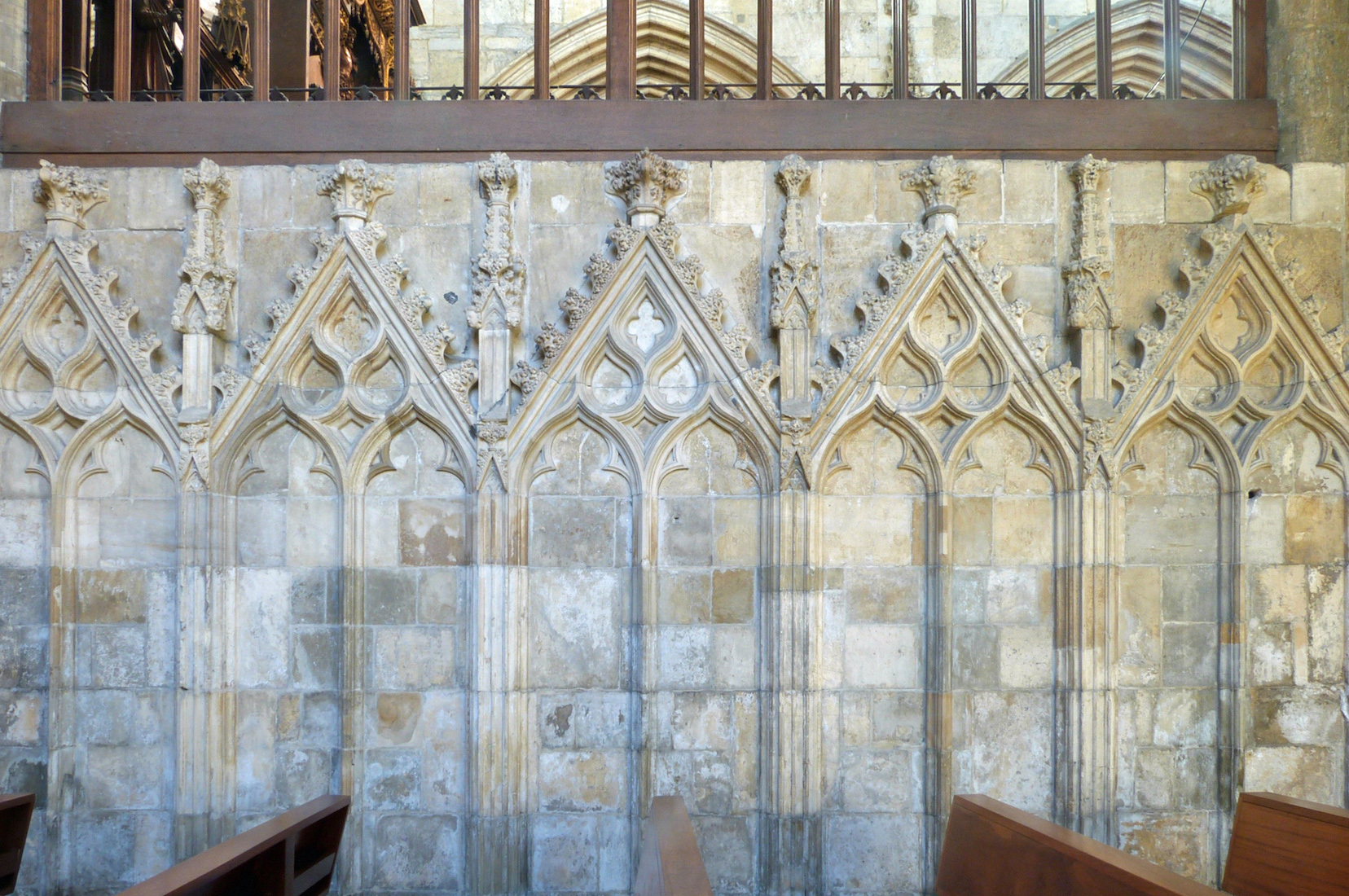
The Northeast chapel is separated from the sanctuary area by a rather plain arcade which also extends around to the East side. INDEX
D17. NORTH CHOIR AISLE AMT
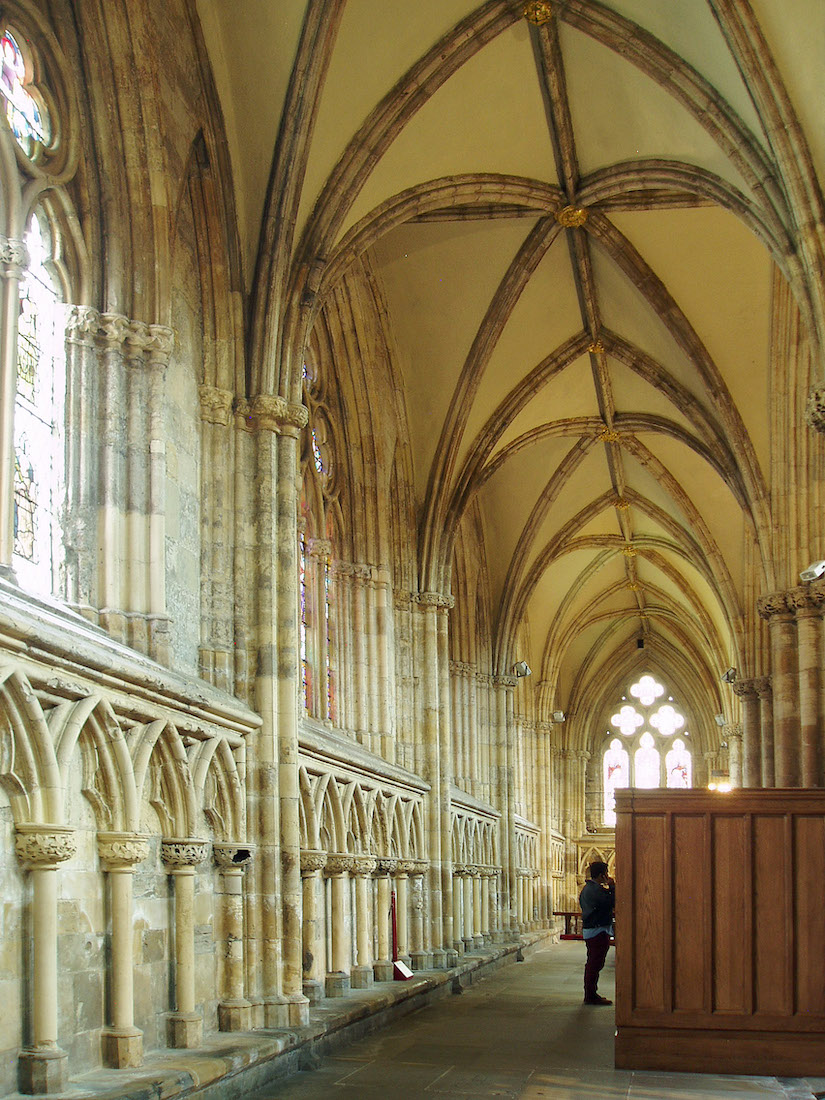
The Northeast chapel has several rows of short pews, but behind these the choir aisle extends back with blind arcading on the North wall. These columns also have decorative capitals, some a little the worse for wear.
D18. MARINERS AND ABRAHAM WINDOWS J&J J&J
Further windows along this wall ... . ••• The so-called Mariners window at left shows the Stilling Of The Storm by William Wailes, 1866. The window is in memory of Thomas Franks, Master Mariner, d.1859 aged 59. Also to Robert Frank d.1843 aged 17, John Frank Master Mariner d.1847 aged 19, Betty Frank d.1841 aged 82, Matthew Brunyard d.1816 aged 55, Mary Brunyard d.1836 aged 61, and John Brunyard d.1861 aged 57. ••• The window at right, also by William Wailes, 1860, depicts stories of Abraham. The top tracery has Masonic images. The window is in memory of James Banks who died in1858 aged 92.
D19. NORTH CHOIR AISLE WINDOWS J&J J&J
These are the last two windows in the North choir aisle. ••• At left is a window with the theme, ‘Victory through His cross alone’. The artist was George Parlby, and the window was created by Ward and Hughes in 1922. It is a memorial to the fallen of Selby who died in the Great War. ••• The window at right shows ‘Saints and Martyrs of the Church’. Saints pictured are St Cedd, St Benedict of Nursia, St Aidan, St Aelred and an unknown Martyr. The date and artist are unknown. The window was given in memory of John Richardson who died in 1884.
D20. LEPER SQUINT SA
Just here towards the end of the aisle there is a short set of metal steps, where we can observe a strange square hole in the wall. It is known as the ‘Leper Squint’, and was the only way for people with leprosy (a mildly contagious, disfiguring disease) to view the services inside the church during medieval times. It is over nine feet long, and would have led to the outside of the Abbey, as lepers were not allowed inside. [Photo Credit: Selby Abbey]
D21. 578 SQUADRON MEMORIAL JAC
Just West of the Leper Squint is a memorial to the 578 Squadron. It comprises a gathering of pieces including the Squadron Memorial Book. This has forty-two acid-free paper leaves bound into embossed goatskin covers and contained in a glazed stainless steel and English oak desk cabinet, and commemorates the loss of forty-three Halifax Mk.III bombers and two hundred and nineteen 578 Squadron airmen who flew out of Burn, never to return. [Burn Airfield is some three mies south of Selby.]
E. CHOIR AND SANCTUARY
E1. CHOIR SCREEN AMT
We now find ourselves back at the crossing. Before us is the wonderful carved choir screen which separates the choir from the crossing. At the top of the screen is a rood cross. INDEX
E2. ROOD CROSS AMT AMT
Many churches and cathedrals have a rood cross – often a crucifix, and often with the accompanying figures of Mary mother of Jesus, and John the beloved disciple. The rood cross is located above or on top of the rood screen (choir screen). There are four emblems at the ends of this cross: traditional symbols of the four evangelists. They are an angel (Matthew), a lion (Mark), a bull (Luke) and an eagle (John). We walk through into the choir.
E3. CHOIR J&J
There is much to see here, but first let us look at the structure of the side walls. Pick out one of the columns. Following upwards from the floor, it leads to its ornate capital, from which springs not only a multi-layered arch, but also a protruding corbel, generally in the form of a grotesque. On its back sits a plinth for a statue (look around – not all the plinths are occupied). The statue is crowned by a pinnacle which is topped by another corbel which supports a slim column attached to the wall. This slim column rises to another fine capital, from which blossoms a series of stone supports which blend perfectly into the main wooden roof joists. These in turn lead to finely carved bosses, where several joists meet. Such beautiful complexity!
E4. CHOIR VAULTING AMT
The vaulting of the choir and sanctuary follows the pattern we observed in the South transept: timber insets between the ribs and large round gold bosses.
E5. CHOIR BOSSES AMT AMT
As before, the bosses have various designs, even including a Green Man! The Green Man is a motif in architecture and art, of a face made of, or completely surrounded by, foliage, which normally spreads out from the centre of the face. Apart from a purely decorative function, the Green Man is primarily interpreted as a symbol of rebirth, representing the cycle of new growth that occurs every spring.
E6. ORGAN PIPES AMT AA
We have shared a little of the history of the Abbey organ. We come now to the ranks of organ pipes, situated on either side of the choir. The carved decorative casing is very ornate. [Photo 2 Credit: Wikimedia Andrewrabbott]
E7. CHOIR LOOKING WEST AMT AMT
There are several items of interest here. Above the flag hanging at left is the Washington Window. The walls above the choir stalls contain many carved figures. And at left is a gold lectern.
E8. WASHINGTON WINDOW J&J
The Washington Window, containing the Heraldic arms of the Washington family, is made of the original fourteenth century glass. The 14th century Washington coat of arms contains three stars above red and white stripes, and is one of the first known representations of the stars and stripes pattern later used for the US flag. The window is thought to commemorate John Wessington, Prior of Durham (1416–1446). Because of the Washington connection, Selby Abbey is on the ‘American Trail’ of attractions around the UK with strong American historical connections.
E9. CAPITAL CARVING AMT x4
Here are some of the many strange figures to be found near the capitals of the columns.
E10. ST HELEN AND LECTERN AMT AMT
Looking at the arches of the choir, there is a niche where each arch meets a column. Many of these niches now stand empty, but one contains a pleasing statue of St Helen. Saint Helen, often referred to as Saint Helena of the Cross, was the mother of the great emperor Constantine. In 306 Constantine became the sole ruler of the Roman Empire. Helena was named Augusta, or empress, in 325, and enjoyed great influence in the imperial court. She converted to Christianity and built many churches in Rome and the Holy Land. On pilgrimage to the Holy Land she found the True Cross, an event recorded by Rufinus Sulpicius Severus and St. Ambrose. She was also known to generously help the poor. Because of her piety, she exerted a great influence over Constantine and he held her in high esteem. St. Helen is often depicted in art as an empress, holding a cross.
E11. CHOIR TO SANCTUARY AMT
We make our way through the choir towards the sanctuary – an impressive sight.
E12. SANCTUARY J&J
We take time to look at the row of kneelers immediately before us, the intricate wrought iron fence, the carved chair at left, all the candles! There is interest also in the arcading either side of the high altar, and in the sedilia at right.
E13. SIDE ARCADE AND SEDILIA AMT AMT
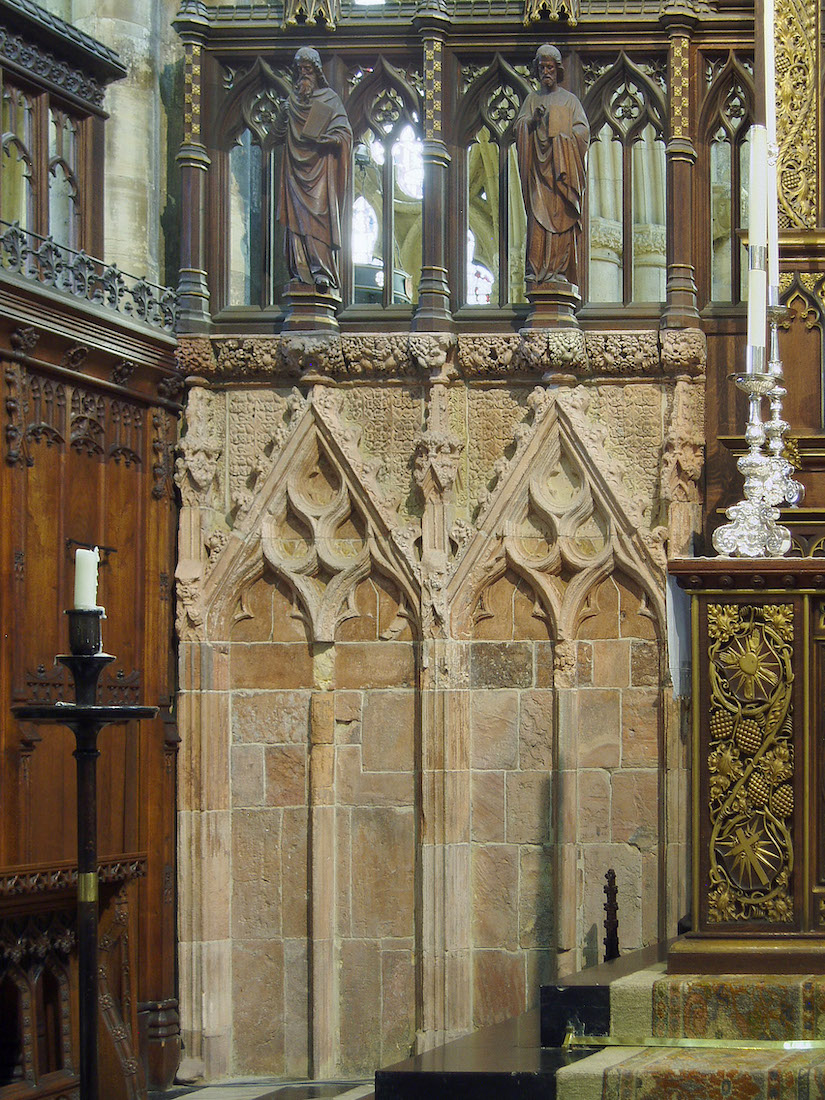

The side arcading is quite detailed, and there are four carved figures atop it – two on either side. At right is a set of (uncomfortable!) stone seats for the clergy known as sedilia (Latin for ‘seats’).
E14. THE SANCTUARY AMT
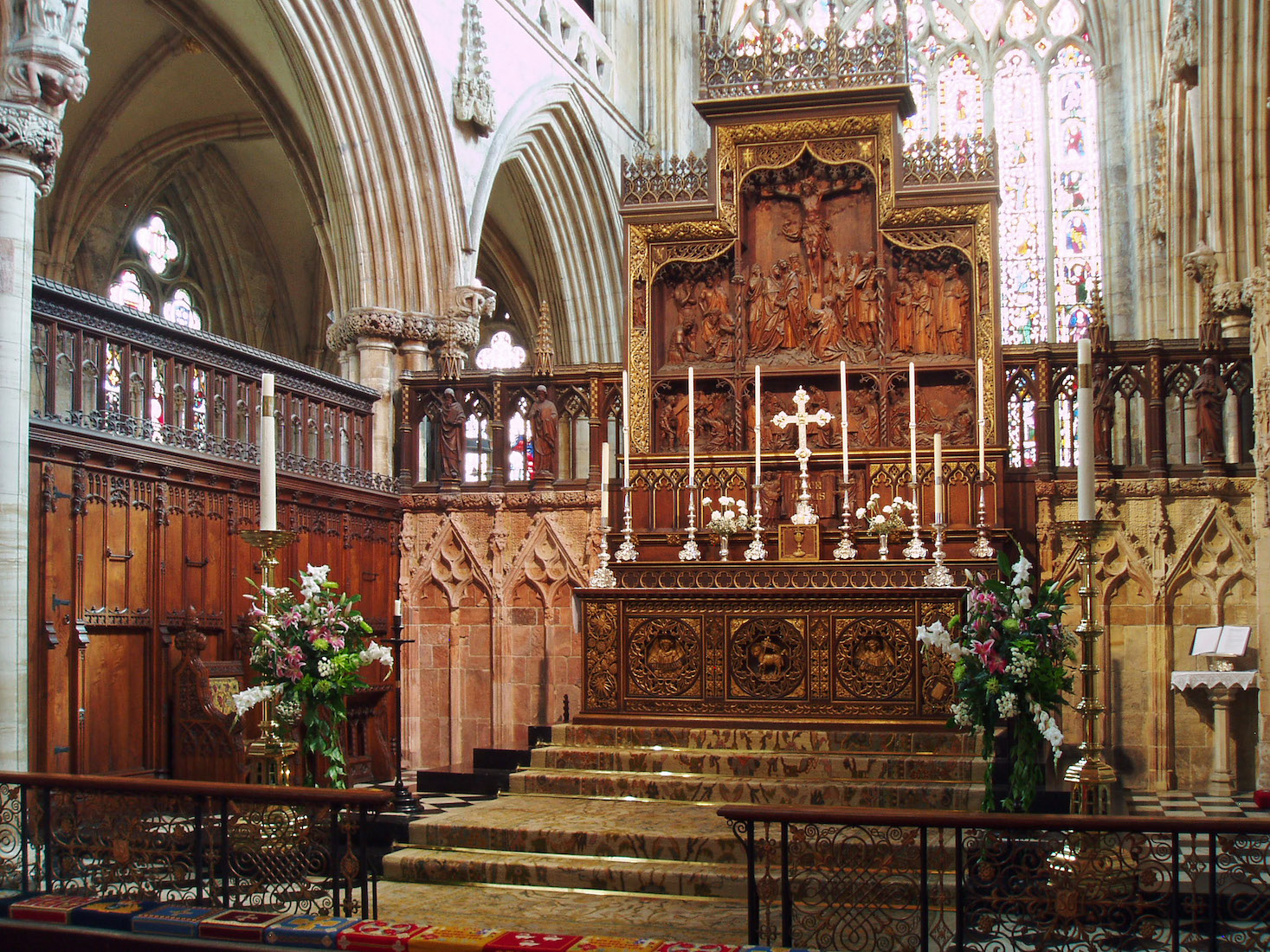
The high altar with its backing reredos and side panelling makes a beautiful setting. There is such a lot of detail here, enhanced by the lovely flower arrangements.
E15. THE HIGH ALTAR AND REREDOS AMT

We focus on the high altar and the reredos – the carved screen behind.
E16. BASE OF HIGH ALTAR AMT
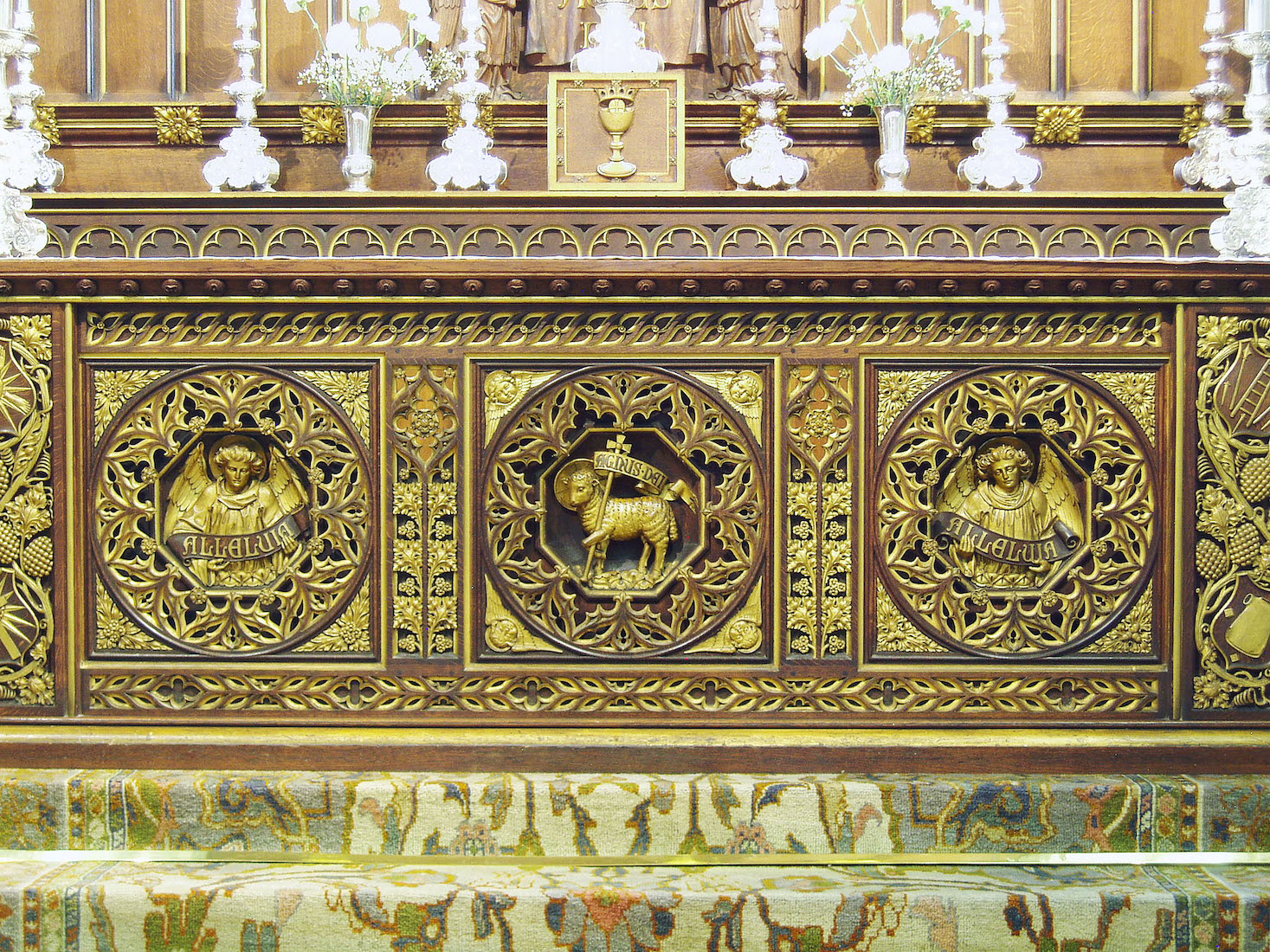
The base of the altar has three square gilt and timber panels. On either side is an angel carrying an ALLELUIA banner. At centre is the Agnus Dei – Lamb of God – the One who takes away the sin of the world.
E17. HIGH ALTAR REREDOS AMT
Our final memory of Selby Abbey will be this scene on the reredos: the Crucifixion of Christ. The scene is one where the Cross is crowded by onlookers – different from the oft-depicted lonely suffering of Christ. There are three panels below, showing from right, Jesus praying in the Garden of Gethsemane with his sleeping disciples, the Last Supper, and Jesus bearing his Cross on his way to Calvary. This completes our visit to Selby Abbey.
CONCLUSION JAC
Selby Abbey was on my list to photograph in 2020 when my travel plans were suddenly disrupted by COVID. So I have greatly enjoyed my virtual visit using the photos of my collaborators! What an interesting Abbey! I hope you have enjoyed visiting it with me.
Almost all the photographs which appear here are by James Alexander Cameron, Aidan McRae Thomson and ‘J & J’, and I am very grateful to each of them for the use of their photos. Ownership is indicated by the initials JAC, AMT and J&J in the titles. Accreditation for other occasional photos is given in the text.
I also express my thanks to my wife Margie who dutifully reads through all my websites and checks the typing.
As usual, I take little credit for the text which comes from a variety of different sources.
I would be glad to receive any comments, criticisms or corrections to this site. The best websites are those which contain no errors!
Selby Abbey has its own website with link
The originals of James’ photographs can be found at:
https://www.flickr.com/photos/jcameronuk/albums/72157658047469619
The originals of Aidan’s photographs can be found at:
https://www.flickr.com/photos/amthomson/sets/72177720296065415/
Similarly the originals of J&J’s photographs can be found at:
https://www.flickr.com/photos/jpguffogg/albums/72177720299368052
Site created 06 / 2023
Paul Scott



